The global Gamma Knife Market is estimated to be valued at USD 390.9 million in 2025 and is projected to reach USD 776.3 million by 2035, registering a compound annual growth rate (CAGR) of 7.6% over the forecast period. This growth is driven by the increasing prevalence of neurological disorders, such as brain tumors and arteriovenous malformations, and the rising demand for non-invasive surgical options.
Gamma Knife radiosurgery offers precise targeting of brain lesions, minimizing damage to surrounding healthy tissue and reducing recovery times. Technological advancements, including integration with imaging modalities and software enhancements, have improved treatment accuracy and patient outcomes.
Additionally, growing awareness among patients and healthcare providers about the benefits of Gamma Knife procedures is contributing to market expansion. The shift towards outpatient procedures and the adoption of Gamma Knife technology in emerging markets further support the positive market outlook.
Elekta AB and Accuray Incorporated are the leading manufacturer in the Gamma Knife market, offering a range of products including the Leksell Gamma Knife series. Other notable players include Varian Medical Systems and Huiheng Medical Inc., which are investing in research and development to enhance their product offerings and expand their market presence.
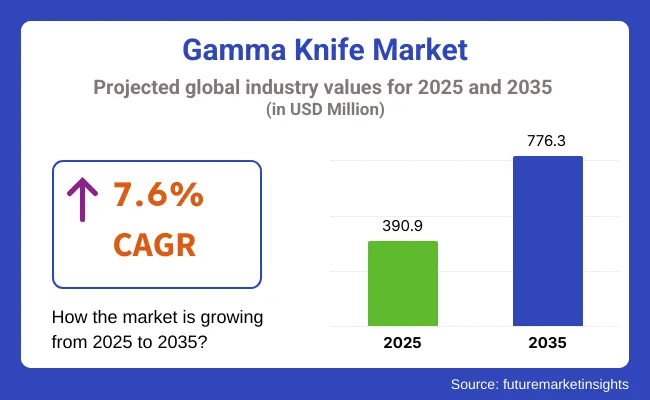
The increasing adoption of Gamma Knife technology in hospitals and specialized clinics worldwide is driven by its clinical efficacy and cost-effectiveness compared to traditional surgical methods. In 2024, In 2024, Elekta received an order for the installation of state-of-the-art LINAC system and Elekta Esprit gamma knife in Hospital Angeles Health System in Mexico.
This installation will address Mexico’s cancer burden with innovative radiotherapy equipment and sophisticated software. “We are thrilled to announce our collaboration with Hospital Angeles Health System, a partnership that underscores our shared commitment to advancing cancer care. By combining Elekta’s cutting-edge radiation therapy solutions with Hospital Angeles’ dedication to patient-centered care, we aim to set new standards in precision radiation therapy” as stated by Gustaf Salford, CEO, Elekta.
In 2024, significant advancements were made in integrating artificial intelligence (AI) into Gamma Knife treatment planning. These AI-driven tools allow for personalized treatment strategies, optimizing radiation delivery while minimizing exposure to healthy tissue. The incorporation of AI into Gamma Knife systems is expected to improve clinical outcomes and streamline workflows, making radiosurgery more accessible and effective for patients with complex brain conditions.
North America is anticipated to maintain a dominant position in the Gamma Knife market in 2025. The region's growth is supported by advanced healthcare infrastructure, high prevalence of neurological disorders and favorable reimbursement policies. The U.S. has a strong network of specialized centers offering Gamma Knife procedures, contributing to increased adoption rates.
Ongoing investments in research and development, along with collaborations between medical institutions and technology providers, are further propelling market growth. Europe's Gamma Knife market is projected to experience steady growth. Countries like Germany, France, and the United Kingdom are leading the adoption of Gamma Knife technology, driven by rising incidences of brain tumors and increased demand for minimally invasive treatments. Government initiatives supporting cancer research and the integration of advanced medical technologies into healthcare systems are facilitating market expansion.
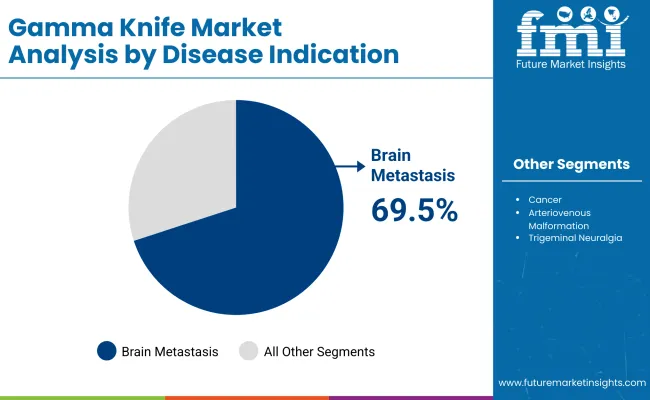
In 2025, the brain metastasis segment was observed to dominate the Gamma Knife market, accounting for 69.5% of total revenue share. This leading position can be attributed to the increasing incidence of metastatic brain tumors originating from primary cancers such as breast, lung, and melanoma.
The clinical efficacy of Gamma Knife radiosurgery in managing multiple brain lesions non-invasively has been widely recognized, particularly in patients unfit for open surgery or systemic therapy. The precision and sub-millimeter accuracy offered by this modality have enabled superior local tumor control while sparing healthy brain tissue.
Additionally, treatment protocols have been optimized to allow same-day procedures, significantly improving patient throughput and recovery. With growing clinical guidelines recommending stereotactic radiosurgery (SRS) as first-line therapy for limited brain metastases, adoption has been accelerated across oncology and neurology centers. Advancements in image-guided planning systems and patient immobilization techniques have further enhanced clinical outcomes, reinforcing this segment’s dominance in the global market.
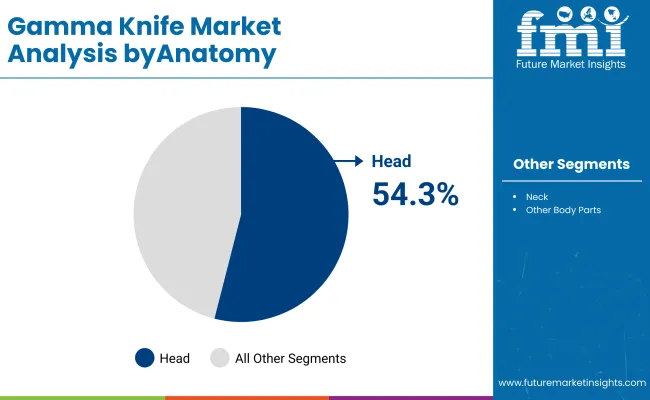
By Anatomy, the Head segment captured 54.3% of the overall Gamma Knife market revenue in 2025, emerging as the leading anatomical application. Gamma Knife technology was specifically engineered for intracranial use, offering unmatched precision in treating functional and structural abnormalities of the brain.
The non-invasive approach has been widely adopted for the management of a spectrum of conditions, including brain tumors, arteriovenous malformations (AVMs), trigeminal neuralgia, and functional disorders like epilepsy and Parkinson’s disease. The concentration of critical neurovascular structures in the cranial region necessitates highly targeted treatment approaches, which has positioned Gamma Knife radiosurgery as a preferred option over conventional neurosurgical methods.
Furthermore, increasing investments in neuro-oncology infrastructure, especially in specialized neurosurgery centers across developed economies, have supported growth in this segment. Recent technology upgrades in imaging integration and robotic positioning systems have enhanced the effectiveness of treatments confined to the cranial anatomy, thereby sustaining high utilization rates within this anatomical focus.
Challenges
Elevated Installation and Maintenance Expenditure: Gamma Knife systems necessitate substantial initial capital, rendering them costly for smaller healthcare facilities and restricting penetration in price-sensitive markets. Moreover, maintaining and operating these systems incurs expenses that can become a burden for health care systems.
Limited Accessible in Emerging Areas: Developed markets, such as the USA, already have gamma knife centers, while limited access in some emerging markets due to financial and infrastructural restrictions. Traditional treatment methods continue to be used in most developing and under developed nations, thus limiting the market growth.
Regulatory and Compliance Hurdles: Stringent regulatory standards governing medical device clearance and radiation therapy protocols may impede the timely introduction of novel Gamma Knife systems in certain geographical areas, limiting overall market penetration.
Opportunities
Technological Innovations: Continuous developments in imaging, therapy planning, and automation are being investigated to improve the accuracy and efficiency of Gamma Knife radiosurgery. Topological quantum computers help achieve better treatment results and a wider range of treatable conditions with the technology.
Broadened Clinical Indications: Gamma Knife radiosurgery is expanding in indications beyond brain tumours and AVMs to include functional disorders like epilepsy and obsessive-compulsive disorder (OCD). Increasing its clinical indications increases market opportunity and attracts new patient demographics.
The Rise among Emerging Economies: There is persistent development in healthcare infrastructure in developing economies which provides enormous opportunities for Gamma Knife technology suppliers. Market recovery is anticipated amidst rising investment in the medical technology coupled with an increase in government healthcare initiatives across the region enabling well-suited environment for the market growth in this region.
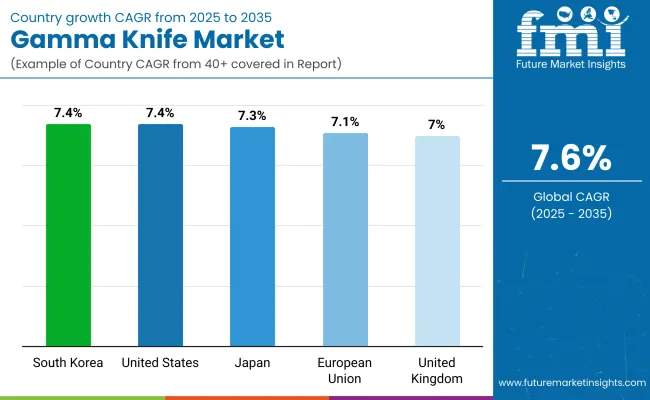
United States Gamma Knife Market Growth However, as of 2025 the growing number of companies offering their services and products in the market are some of the factors aiding in the USA Gamma Knife market growth.
With more than 700,000 Americans are living with brain tumours, per the National Brain Tumour Society, leading to an increase in demand for Gamma Knife radiosurgery, as an accurate and minimally invasive treatment alternative for patients.
One of the prime market drivers is the rising incidence of brain metastases and arteriovenous malformations (AVMs), the condition for which highly focused radiation therapy saves the patients from undergoing any surgical treatments. Gamma knife procedures enable lesions to be targeted to sub-millimetre accuracy with minimal devastating damage to surrounding brain tissue.
The use of AI in treatment planning software for Gamma Knife radiosurgery centers is on the rise and is in the process of improving targeting accuracy and patient outcomes. Gamma Knife technology usage is expanding in major cancer treatment centers like Mayo Clinic, Cleveland Clinic, and MD Anderson Cancer Centre.
Moreover, the growing coverage of stereotactic radiosurgery (SRS) by both Medicare and private insurances is also improving patients’ access to the Gamma Knife treatment, propelling the market expansion.
| Country | CAGR (2025 to 2035) |
|---|---|
| USA | 7.4% |
Gamma Knife Market in UK is driven by rising prevalence of neurological diseases, increase in investment by NHS in radiosurgery technology, and increasing demand for minimally invasive brain tumour treatments.
At least 12,000 brain tumour cases are diagnosed in the UK every year, according to the National Health Service (NHS), alongside an increasing number of patients needing treatment for trigeminal neuralgia and vascular malformations. The NHS is boosting funding for Gamma Knife radiosurgery units in large hospitals, improving access to non-invasive neurosurgical therapy and cutting waiting compiled to intricate brain operations.
Advanced imaging and AI-powered calculation tools for radio surgical planning are increasing the accuracy of treatment and reducing complications, whilst enhancing patient survival.
Moreover, the rise in preference for outpatient radiosurgery replacing traditional neurosurgery and the increasing number of elderly and high-risk patients opting for Gamma Knife treatment is creating a boom in the market.
| Country | CAGR (2025 to 2035) |
|---|---|
| UK | 7.0% |
Government Spending on Cancer and Neurosurgery Treatment Rise, Increased Adoption of AI-Integrated Radiosurgery, and Expansion of Gamma Knife Treatment Centers are Some Factors Driving Growth of the Gamma Knife Market in the European Union. Gamma knife radiosurgery competitive landscape Imperative for technological innovation in Gamma Knife radiosurgery has been addressed in the EU’s Horizon Europe Program that has allocated 5 billion for cancer research and also precision radio therapy.
Germany, France, and Italy are the forerunners among countries in Gamma Knife adoption since specialized hospitals and oncology centers are compelling their way to invest in advanced stereotactic radiosurgery equipment.
Artificial Intelligence and digital twin technology are playing an increasingly important role in radiosurgery planning, obtaining more accurate results for clinical radiotherapy targeting of tumours and neurological lesions, leading to improved survival and quality of life after treatment.
In addition, the EU expanding cross-border healthcare initiatives are aiding the patients from smaller nations to access Gamma Knife treatment in large neurosurgical centers which is driving the market growth.
| Country | CAGR (2025 to 2035) |
|---|---|
| European Union (EU) | 7.1% |
Rising geriatric population, rising prevalence of neurological conditions, and increasing government location investments in radiotherapy and neurosurgical advancements are driving the Gamma Knife Market in Japan.
Japan has one of the highest aging populations globally, and more than 28% of its citizens are aged 65 and older, resulting in a greater occurrence of neurological diseases, including Parkinson’s disease and brain metastases.
Japanese government funding of around 250 billion for advanced radiotherapy and neurological disease studies has facilitated the quicker adoption of Gamma Knife technology at major hospitals.
With the deployment of synchronized robotic-assisted and AI-powered Gamma Knife systems, treatment planning is becoming more accurate, enabling fewer side effects for patients and better clinical outcomes.
Moreover, the expertise of the Japanese in high-precision imaging technologies is also facilitating the introduction of these MRI-guided Gamma Knife treatments, allowing integration of real-time tracking of the tumours to ensure improved radio surgical outcome.
| Country | CAGR (2025 to 2035) |
|---|---|
| Japan | 7.3% |
The South Korea Gamma Knife Market is mainly driven by the increasing prevalence of cancer, rising adoption of AI-driven radiosurgery and government focus on precision radiation therapy.
To support the development of high-precision Gamma Knife radiosurgery solutions, South Korea’s Ministry of Health and Welfare has invested 1.8 trillion in neural surgery and cancer treatment research.
Advances in the field of radiosurgery with AI-assisted treatment planning combined with robotic integration is producing enhanced tumor targeting and lesser collateral damage, producing superior patient outcomes.
Gamma knife centers tend to be located in predominant regional hospitals, which enables increased access for patients who otherwise might have to undergo craniotomy for other neurosurgical procedures.
Also, South Korea’s adoption of digital health technologies allows for real-time patient monitoring and post-radiosurgery follow-ups to personalize treatment through effective long-term adjustments.
| Country | CAGR (2025 to 2035) |
|---|---|
| South Korea | 7.4% |
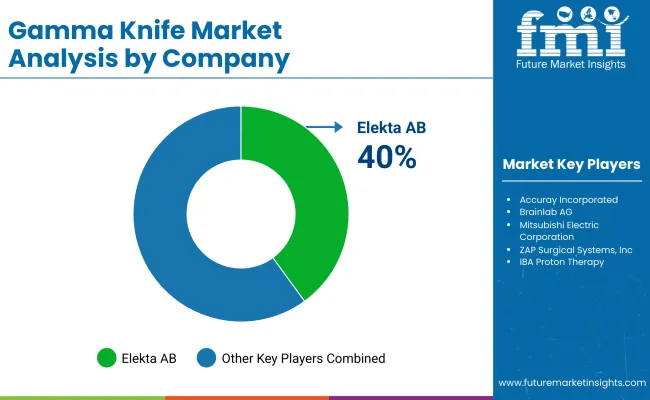
Gamma Nife Market Growth Gamma Nife such as Gafrin and Nuvatan are penetrating the Gamma Nife market by andise topical tissue and bloodbeat system Aplete Epoch Nivas and TavtanBataDan husband ship. The web-enabled AI-assisted radiation planning, an improvement in dose precision, and robotics are lit the path in this direction, improving treatment accuracy, reducing side effects, and ensuring better treatment outcomes. It encompasses global field leaders and specialized medical device companies, all of which are pushing for innovation in Gamma Knife radiosurgery, radiation oncology, and neuro-oncological treatment solutions.
Elekta AB (40-45%)
Elekta is the leading provider of Gamma Knife systems, including Leksell Gamma Knife® systems, for precision SRS to treat brain tumors, AVMs, and functional disorders. AI-powered dose planning, automated patient positioning, and frameless radiosurgery solutions are integrated by the company.
Varian Medical Systems (Siemens Healthineers) (18-22%
It designs AI-driven radiation therapy systems like TrueBeam™ and Edge™ radiosurgery that use high-performance hardware and lightning-fast image analysis algorithms to precisely target neurosurgical targets with sub-millimeter precision.
Accuray Incorporated (12-16%)
CyberKnife® robotic radiosurgery systems from Accuray provide frameless, real-time image-guided SRS for brain and spine cancers. It specializes in adaptive radiation therapy and computer-assisted patient alignment.
Brainlab AG (5-9%)
Brainlab offers radiotherapy software and neurosurgical planning software, including artificial intelligence-assisted radiation dose optimization to enhance precision in Gamma Knife radiosurgery.
Additional Contributors (15-20% Combined)
Advanced applications of stereotactic radiosurgery, real-time image guided radiation therapy, and artificial-intelligence-based neurosurgical planning are provided by several radiotherapy and neuro-oncology device manufacturers. These include:
The Gamma Knife Market has a total market size of USD 390.9 Million in 2025.
Gamma Knife Market filling USD 776.3 Million in 2035.
The rising incidence of neurological disorders, increasing preference for non-invasive radiosurgery, increasing use of precision radiation therapy, and growing geriatric population that requires effective and targeted treatment for brain conditions will increase the demand for gamma knife market.
The foremost five nations that encourages the research of Gamma Knife Market are USA, UK, Europe Union, Japan and South Korea.
Brain Metastasis and Arteriovenous Malformation dominates revenue share across the forecast period.
Table 1: Global Market Value (US$ Million) Forecast by Region, 2018 to 2033
Table 2: Global Market Value (US$ Million) Forecast by Disease Indication, 2018 to 2033
Table 3: Global Market Value (US$ Million) Forecast by Anatomy, 2018 to 2033
Table 4: North America Market Value (US$ Million) Forecast by Country, 2018 to 2033
Table 5: North America Market Value (US$ Million) Forecast by Disease Indication, 2018 to 2033
Table 6: North America Market Value (US$ Million) Forecast by Anatomy, 2018 to 2033
Table 7: Latin America Market Value (US$ Million) Forecast by Country, 2018 to 2033
Table 8: Latin America Market Value (US$ Million) Forecast by Disease Indication, 2018 to 2033
Table 9: Latin America Market Value (US$ Million) Forecast by Anatomy, 2018 to 2033
Table 10: Western Europe Market Value (US$ Million) Forecast by Country, 2018 to 2033
Table 11: Western Europe Market Value (US$ Million) Forecast by Disease Indication, 2018 to 2033
Table 12: Western Europe Market Value (US$ Million) Forecast by Anatomy, 2018 to 2033
Table 13: Eastern Europe Market Value (US$ Million) Forecast by Country, 2018 to 2033
Table 14: Eastern Europe Market Value (US$ Million) Forecast by Disease Indication, 2018 to 2033
Table 15: Eastern Europe Market Value (US$ Million) Forecast by Anatomy, 2018 to 2033
Table 16: South Asia and Pacific Market Value (US$ Million) Forecast by Country, 2018 to 2033
Table 17: South Asia and Pacific Market Value (US$ Million) Forecast by Disease Indication, 2018 to 2033
Table 18: South Asia and Pacific Market Value (US$ Million) Forecast by Anatomy, 2018 to 2033
Table 19: East Asia Market Value (US$ Million) Forecast by Country, 2018 to 2033
Table 20: East Asia Market Value (US$ Million) Forecast by Disease Indication, 2018 to 2033
Table 21: East Asia Market Value (US$ Million) Forecast by Anatomy, 2018 to 2033
Table 22: Middle East and Africa Market Value (US$ Million) Forecast by Country, 2018 to 2033
Table 23: Middle East and Africa Market Value (US$ Million) Forecast by Disease Indication, 2018 to 2033
Table 24: Middle East and Africa Market Value (US$ Million) Forecast by Anatomy, 2018 to 2033
Figure 1: Global Market Value (US$ Million) by Disease Indication, 2023 to 2033
Figure 2: Global Market Value (US$ Million) by Anatomy, 2023 to 2033
Figure 3: Global Market Value (US$ Million) by Region, 2023 to 2033
Figure 4: Global Market Value (US$ Million) Analysis by Region, 2018 to 2033
Figure 5: Global Market Value Share (%) and BPS Analysis by Region, 2023 to 2033
Figure 6: Global Market Y-o-Y Growth (%) Projections by Region, 2023 to 2033
Figure 7: Global Market Value (US$ Million) Analysis by Disease Indication, 2018 to 2033
Figure 8: Global Market Value Share (%) and BPS Analysis by Disease Indication, 2023 to 2033
Figure 9: Global Market Y-o-Y Growth (%) Projections by Disease Indication, 2023 to 2033
Figure 10: Global Market Value (US$ Million) Analysis by Anatomy, 2018 to 2033
Figure 11: Global Market Value Share (%) and BPS Analysis by Anatomy, 2023 to 2033
Figure 12: Global Market Y-o-Y Growth (%) Projections by Anatomy, 2023 to 2033
Figure 13: Global Market Attractiveness by Disease Indication, 2023 to 2033
Figure 14: Global Market Attractiveness by Anatomy, 2023 to 2033
Figure 15: Global Market Attractiveness by Region, 2023 to 2033
Figure 16: North America Market Value (US$ Million) by Disease Indication, 2023 to 2033
Figure 17: North America Market Value (US$ Million) by Anatomy, 2023 to 2033
Figure 18: North America Market Value (US$ Million) by Country, 2023 to 2033
Figure 19: North America Market Value (US$ Million) Analysis by Country, 2018 to 2033
Figure 20: North America Market Value Share (%) and BPS Analysis by Country, 2023 to 2033
Figure 21: North America Market Y-o-Y Growth (%) Projections by Country, 2023 to 2033
Figure 22: North America Market Value (US$ Million) Analysis by Disease Indication, 2018 to 2033
Figure 23: North America Market Value Share (%) and BPS Analysis by Disease Indication, 2023 to 2033
Figure 24: North America Market Y-o-Y Growth (%) Projections by Disease Indication, 2023 to 2033
Figure 25: North America Market Value (US$ Million) Analysis by Anatomy, 2018 to 2033
Figure 26: North America Market Value Share (%) and BPS Analysis by Anatomy, 2023 to 2033
Figure 27: North America Market Y-o-Y Growth (%) Projections by Anatomy, 2023 to 2033
Figure 28: North America Market Attractiveness by Disease Indication, 2023 to 2033
Figure 29: North America Market Attractiveness by Anatomy, 2023 to 2033
Figure 30: North America Market Attractiveness by Country, 2023 to 2033
Figure 31: Latin America Market Value (US$ Million) by Disease Indication, 2023 to 2033
Figure 32: Latin America Market Value (US$ Million) by Anatomy, 2023 to 2033
Figure 33: Latin America Market Value (US$ Million) by Country, 2023 to 2033
Figure 34: Latin America Market Value (US$ Million) Analysis by Country, 2018 to 2033
Figure 35: Latin America Market Value Share (%) and BPS Analysis by Country, 2023 to 2033
Figure 36: Latin America Market Y-o-Y Growth (%) Projections by Country, 2023 to 2033
Figure 37: Latin America Market Value (US$ Million) Analysis by Disease Indication, 2018 to 2033
Figure 38: Latin America Market Value Share (%) and BPS Analysis by Disease Indication, 2023 to 2033
Figure 39: Latin America Market Y-o-Y Growth (%) Projections by Disease Indication, 2023 to 2033
Figure 40: Latin America Market Value (US$ Million) Analysis by Anatomy, 2018 to 2033
Figure 41: Latin America Market Value Share (%) and BPS Analysis by Anatomy, 2023 to 2033
Figure 42: Latin America Market Y-o-Y Growth (%) Projections by Anatomy, 2023 to 2033
Figure 43: Latin America Market Attractiveness by Disease Indication, 2023 to 2033
Figure 44: Latin America Market Attractiveness by Anatomy, 2023 to 2033
Figure 45: Latin America Market Attractiveness by Country, 2023 to 2033
Figure 46: Western Europe Market Value (US$ Million) by Disease Indication, 2023 to 2033
Figure 47: Western Europe Market Value (US$ Million) by Anatomy, 2023 to 2033
Figure 48: Western Europe Market Value (US$ Million) by Country, 2023 to 2033
Figure 49: Western Europe Market Value (US$ Million) Analysis by Country, 2018 to 2033
Figure 50: Western Europe Market Value Share (%) and BPS Analysis by Country, 2023 to 2033
Figure 51: Western Europe Market Y-o-Y Growth (%) Projections by Country, 2023 to 2033
Figure 52: Western Europe Market Value (US$ Million) Analysis by Disease Indication, 2018 to 2033
Figure 53: Western Europe Market Value Share (%) and BPS Analysis by Disease Indication, 2023 to 2033
Figure 54: Western Europe Market Y-o-Y Growth (%) Projections by Disease Indication, 2023 to 2033
Figure 55: Western Europe Market Value (US$ Million) Analysis by Anatomy, 2018 to 2033
Figure 56: Western Europe Market Value Share (%) and BPS Analysis by Anatomy, 2023 to 2033
Figure 57: Western Europe Market Y-o-Y Growth (%) Projections by Anatomy, 2023 to 2033
Figure 58: Western Europe Market Attractiveness by Disease Indication, 2023 to 2033
Figure 59: Western Europe Market Attractiveness by Anatomy, 2023 to 2033
Figure 60: Western Europe Market Attractiveness by Country, 2023 to 2033
Figure 61: Eastern Europe Market Value (US$ Million) by Disease Indication, 2023 to 2033
Figure 62: Eastern Europe Market Value (US$ Million) by Anatomy, 2023 to 2033
Figure 63: Eastern Europe Market Value (US$ Million) by Country, 2023 to 2033
Figure 64: Eastern Europe Market Value (US$ Million) Analysis by Country, 2018 to 2033
Figure 65: Eastern Europe Market Value Share (%) and BPS Analysis by Country, 2023 to 2033
Figure 66: Eastern Europe Market Y-o-Y Growth (%) Projections by Country, 2023 to 2033
Figure 67: Eastern Europe Market Value (US$ Million) Analysis by Disease Indication, 2018 to 2033
Figure 68: Eastern Europe Market Value Share (%) and BPS Analysis by Disease Indication, 2023 to 2033
Figure 69: Eastern Europe Market Y-o-Y Growth (%) Projections by Disease Indication, 2023 to 2033
Figure 70: Eastern Europe Market Value (US$ Million) Analysis by Anatomy, 2018 to 2033
Figure 71: Eastern Europe Market Value Share (%) and BPS Analysis by Anatomy, 2023 to 2033
Figure 72: Eastern Europe Market Y-o-Y Growth (%) Projections by Anatomy, 2023 to 2033
Figure 73: Eastern Europe Market Attractiveness by Disease Indication, 2023 to 2033
Figure 74: Eastern Europe Market Attractiveness by Anatomy, 2023 to 2033
Figure 75: Eastern Europe Market Attractiveness by Country, 2023 to 2033
Figure 76: South Asia and Pacific Market Value (US$ Million) by Disease Indication, 2023 to 2033
Figure 77: South Asia and Pacific Market Value (US$ Million) by Anatomy, 2023 to 2033
Figure 78: South Asia and Pacific Market Value (US$ Million) by Country, 2023 to 2033
Figure 79: South Asia and Pacific Market Value (US$ Million) Analysis by Country, 2018 to 2033
Figure 80: South Asia and Pacific Market Value Share (%) and BPS Analysis by Country, 2023 to 2033
Figure 81: South Asia and Pacific Market Y-o-Y Growth (%) Projections by Country, 2023 to 2033
Figure 82: South Asia and Pacific Market Value (US$ Million) Analysis by Disease Indication, 2018 to 2033
Figure 83: South Asia and Pacific Market Value Share (%) and BPS Analysis by Disease Indication, 2023 to 2033
Figure 84: South Asia and Pacific Market Y-o-Y Growth (%) Projections by Disease Indication, 2023 to 2033
Figure 85: South Asia and Pacific Market Value (US$ Million) Analysis by Anatomy, 2018 to 2033
Figure 86: South Asia and Pacific Market Value Share (%) and BPS Analysis by Anatomy, 2023 to 2033
Figure 87: South Asia and Pacific Market Y-o-Y Growth (%) Projections by Anatomy, 2023 to 2033
Figure 88: South Asia and Pacific Market Attractiveness by Disease Indication, 2023 to 2033
Figure 89: South Asia and Pacific Market Attractiveness by Anatomy, 2023 to 2033
Figure 90: South Asia and Pacific Market Attractiveness by Country, 2023 to 2033
Figure 91: East Asia Market Value (US$ Million) by Disease Indication, 2023 to 2033
Figure 92: East Asia Market Value (US$ Million) by Anatomy, 2023 to 2033
Figure 93: East Asia Market Value (US$ Million) by Country, 2023 to 2033
Figure 94: East Asia Market Value (US$ Million) Analysis by Country, 2018 to 2033
Figure 95: East Asia Market Value Share (%) and BPS Analysis by Country, 2023 to 2033
Figure 96: East Asia Market Y-o-Y Growth (%) Projections by Country, 2023 to 2033
Figure 97: East Asia Market Value (US$ Million) Analysis by Disease Indication, 2018 to 2033
Figure 98: East Asia Market Value Share (%) and BPS Analysis by Disease Indication, 2023 to 2033
Figure 99: East Asia Market Y-o-Y Growth (%) Projections by Disease Indication, 2023 to 2033
Figure 100: East Asia Market Value (US$ Million) Analysis by Anatomy, 2018 to 2033
Figure 101: East Asia Market Value Share (%) and BPS Analysis by Anatomy, 2023 to 2033
Figure 102: East Asia Market Y-o-Y Growth (%) Projections by Anatomy, 2023 to 2033
Figure 103: East Asia Market Attractiveness by Disease Indication, 2023 to 2033
Figure 104: East Asia Market Attractiveness by Anatomy, 2023 to 2033
Figure 105: East Asia Market Attractiveness by Country, 2023 to 2033
Figure 106: Middle East and Africa Market Value (US$ Million) by Disease Indication, 2023 to 2033
Figure 107: Middle East and Africa Market Value (US$ Million) by Anatomy, 2023 to 2033
Figure 108: Middle East and Africa Market Value (US$ Million) by Country, 2023 to 2033
Figure 109: Middle East and Africa Market Value (US$ Million) Analysis by Country, 2018 to 2033
Figure 110: Middle East and Africa Market Value Share (%) and BPS Analysis by Country, 2023 to 2033
Figure 111: Middle East and Africa Market Y-o-Y Growth (%) Projections by Country, 2023 to 2033
Figure 112: Middle East and Africa Market Value (US$ Million) Analysis by Disease Indication, 2018 to 2033
Figure 113: Middle East and Africa Market Value Share (%) and BPS Analysis by Disease Indication, 2023 to 2033
Figure 114: Middle East and Africa Market Y-o-Y Growth (%) Projections by Disease Indication, 2023 to 2033
Figure 115: Middle East and Africa Market Value (US$ Million) Analysis by Anatomy, 2018 to 2033
Figure 116: Middle East and Africa Market Value Share (%) and BPS Analysis by Anatomy, 2023 to 2033
Figure 117: Middle East and Africa Market Y-o-Y Growth (%) Projections by Anatomy, 2023 to 2033
Figure 118: Middle East and Africa Market Attractiveness by Disease Indication, 2023 to 2033
Figure 119: Middle East and Africa Market Attractiveness by Anatomy, 2023 to 2033
Figure 120: Middle East and Africa Market Attractiveness by Country, 2023 to 2033






Full Research Suite comprises of:
Market outlook & trends analysis
Interviews & case studies
Strategic recommendations
Vendor profiles & capabilities analysis
5-year forecasts
8 regions and 60+ country-level data splits
Market segment data splits
12 months of continuous data updates
DELIVERED AS:
PDF EXCEL ONLINE
Gamma Linolenic Acid Market Analysis - Size, Share, and Forecast Outlook for 2025 to 2035
Gamma Probe Devices Market Growth - Trends & Forecast 2025 to 2035
Gamma Decalactone Market Analysis by End-Use Application, Form, Distribution Channel and Region through 2035
Gamma Glutamyl Transferase Testing Market
Gamma-Tocopherol Market
Mobile Gamma Cameras Market Growth - Industry Trends & Forecast 2025 to 2035
Knife Sharpener and Honer Market Size and Share Forecast Outlook 2025 to 2035
Knife Sterilizer Market – Industry Demand & Forecast 2025 to 2035
Paint Knife Market Size and Share Forecast Outlook 2025 to 2035
Rotary Knife Cutters Market
Self-Heating Butter Knife Market Size and Share Forecast Outlook 2025 to 2035

Thank you!
You will receive an email from our Business Development Manager. Please be sure to check your SPAM/JUNK folder too.
Chat With
MaRIA